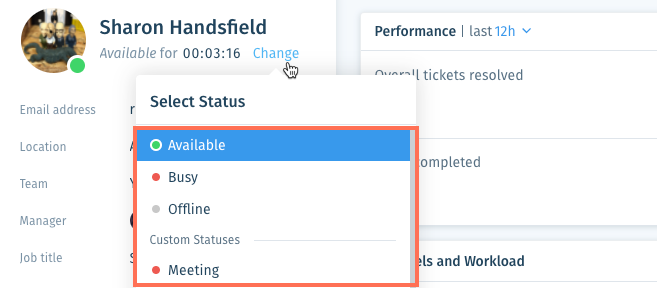
An Agent working in a contact center, staying attuned to the real-time status and availability of other agents is paramount for delivering exceptional customer service. This is where presence technology plays a pivotal role within the agent’s desktop. This comprehensive guide explores the five presence technologies in contact centers, examining their definitions, benefits, implementation strategies, and future implications for customer engagement.

Understanding Presence Technology:
Presence technology is a communication feature that provides real-time information about the status and availability of individuals within an organization. In the context of contact centers, presence technology offers insights into the availability, location, and current activity of agents, allowing for more efficient and responsive customer interactions.
Key Components of Presence Technology:
- Agent Status: Indicates whether an agent is available, busy, on a break, or away from their desk.
- Activity Status: Specifies the current task or interaction an agent is engaged in, such as a call, chat, or email.
- Location Information: Provides details about the physical or virtual location of an agent.
Benefits of Presence Technology in Contact Centers:
1. Enhanced Customer Experience:
- Real-Time Assistance: Enables agents to respond promptly to customer inquiries, reducing wait times and enhancing overall satisfaction.
- Personalized Interactions: Facilitates a more personalized customer experience by connecting customers with available agents based on their expertise.
2. Improved Operational Efficiency:
- Optimized Resource Allocation: Allows supervisors to allocate resources effectively by assigning tasks to available agents.
- Reduced Downtime: Minimizes idle time by ensuring that agents are actively engaged in customer interactions or tasks.
3. Seamless Collaboration:
- Agent Connectivity: Fosters collaboration among agents by providing visibility into each other’s status and availability.
- Cross-Team Communication: Supports communication between different teams or departments, streamlining information exchange.
4. Multi-Channel Support:
- Omnichannel Integration: Integrates with various communication channels, such as voice, chat, and email, for a unified and seamless customer experience.
- Efficient Channel Switching: Enables agents to handle multiple channels simultaneously, optimizing their workload.
5. Proactive Issue Resolution:
- Quick Problem Resolution: Allows supervisors to identify potential issues or bottlenecks in real-time and take proactive measures.
- Task Reassignment: Enables the reassignment of tasks based on agent availability and expertise to address urgent matters promptly.
Implementation Strategies for Presence Technology:
1. Integration with Communication Systems:
- Unified Communication Platforms: Integrate presence technology with unified communication systems to provide a consolidated view of agents’ status across various communication channels.
- VoIP Integration: Seamlessly incorporate presence features into Voice over Internet Protocol (VoIP) systems for real-time insights during calls.
2. Customizable Presence States:
- Tailored Agent States: Allow customization of agent states to align with the specific needs and workflow of the contact center.
- Dynamic Updates: Ensure that presence status automatically updates based on agents’ activities and interactions.
3. Mobile Accessibility:
- Mobile Presence Apps: Develop or leverage mobile applications that provide agents with real-time presence information, especially when they are not at their desks.
- Remote Accessibility: Extend the functionality of presence technology to support agents working remotely or in different locations.
4. Analytics and Reporting:
- Performance Metrics: Implement analytics tools to track key performance metrics related to agent availability, response times, and overall efficiency.
- Historical Data Analysis: Analyze historical presence data to identify trends, peak times, and areas for improvement in workforce management.
5. Training and Change Management:
- Agent Training: Conduct comprehensive training programs to familiarize agents and supervisors with the features and benefits of presence technology.
- Change Management: Implement change management strategies to ease the transition to presence-enabled workflows and address any resistance or concerns among staff.
Challenges and Considerations:
1. Privacy and Security Concerns:
- Data Protection: Ensure that presence technology adheres to data protection regulations and safeguards sensitive information about agents.
- Access Controls: Implement robust access controls to restrict unauthorized access to presence data.
2. Adoption and User Resistance:
- Agent Buy-In: Secure buy-in from agents by highlighting the positive impact of presence technology on their workflow and overall efficiency.
- User-Friendly Interfaces: Opt for user-friendly interfaces that make it easy for agents and supervisors to navigate and utilize presence features.
3. Integration Complexity:
- System Compatibility: Address integration challenges by selecting presence technology solutions that seamlessly integrate with existing contact center systems.
- Vendor Support: Choose vendors with a track record of providing reliable support during the integration process.
4. Data Accuracy and Timeliness:
- Real-Time Updates: Ensure that presence information is updated in real-time to reflect the current status and availability of agents.
- Data Accuracy Checks: Implement regular checks and validation processes to maintain the accuracy of presence data.
Future Trends and Evolutions:
1. Artificial Intelligence (AI) Integration:
- Predictive Presence: AI algorithms predicting agent availability based on historical patterns and current workload.
- Automated Task Assignment: AI-driven automation for intelligent task assignment based on agent skills and availability.
2. IoT and Wearable Devices:
- Wearable Presence: Integration with IoT devices and wearables to provide presence information even when agents are not at their desks.
- Location Tracking: Utilizing location-based services for enhanced presence accuracy.
3. Enhanced Analytics and Reporting:
- Predictive Analytics: Advanced predictive analytics for anticipating peak times, optimizing workforce management, and improving overall operational efficiency.
- Behavioral Analytics: Analyzing agent behavior patterns to enhance training programs and optimize workflow processes.
4. Continued Emphasis on User Experience:
- Intuitive Interfaces: Development of intuitive and user-friendly interfaces to enhance the overall user experience for agents and supervisors.
- Mobile-Centric Solutions: Increasing focus on mobile-centric solutions to accommodate the growing trend of remote and mobile workforce.
Summary: The Role of Presence Technology in Contact Centers
As contact centers evolve to meet the ever-changing demands of customer service, the role of presence technology becomes increasingly crucial. By providing real-time insights into agent availability, activity, and location, presence technology empowers contact centers to deliver more efficient, personalized, and seamless customer interactions. Successful implementation involves careful consideration of customization, integration, training, and addressing privacy concerns. Looking ahead, the integration of AI, IoT, and continued enhancements in analytics will shape the future of presence technology, further elevating its impact on the dynamics of contact centers and redefining the standards of customer engagement.
